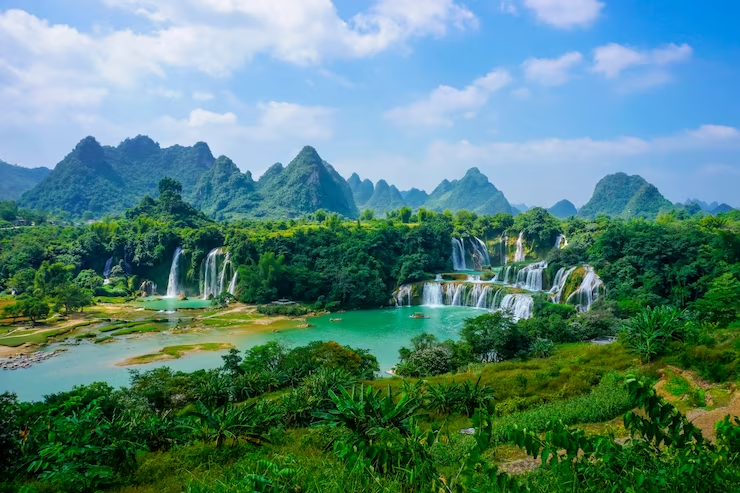In the heart of the Indian subcontinent lies a tapestry of breathtaking landscapes, teeming with biodiversity and adorned with natural wonders that have captivated explorers and poets for centuries. India, with its rich and diverse ecosystems, is a playground for nature enthusiasts, offering a kaleidoscope of experiences that range from the majestic peaks of the Himalayas to the pristine beaches of the Andaman Islands. Join us on an exhilarating journey as we unravel the story of nature in India, exploring its lush forests, cascading waterfalls, and vibrant wildlife that collectively create a symphony of life.

Image by 4045 on Freepik
1. Majestic Peaks and Spiritual Retreats:
Stand in awe of the Himalayas, the crown jewel of India’s natural wonders. From the snow-capped peaks of the mighty Everest to the spiritual retreats nestled in the lap of the mountains, the Himalayas offer a transcendental experience that blends adventure with introspection.
2. Floral Extravaganza: Valley of Flowers and Rhododendron Sanctuaries:
Wander through the Valley of Flowers in Uttarakhand, a UNESCO World Heritage Site bursting with a kaleidoscope of alpine flowers. Explore the rhododendron sanctuaries in Himachal Pradesh, where vibrant blooms paint the mountains in hues of red, pink, and white.
3. Wildlife in the High Altitudes: Snow Leopards and Red Pandas:
Encounter the elusive inhabitants of the high-altitude regions, including the enigmatic snow leopards and the charismatic red pandas. Conservation efforts in the Himalayas are vital for preserving these unique species and ensuring the ecological balance of the region.
1. Lush Rainforests: Silent Valleys and Amboli Ghats:
Explore the lush rainforests of the Western Ghats, home to Silent Valley and Amboli Ghats. These biodiversity hotspots harbor a treasure trove of plant and animal species, making them critical ecosystems for conservation.
2. Breathtaking Waterfalls: Dudhsagar and Athirappilly:
Stand before the breathtaking cascades of Dudhsagar in Goa and Athirappilly in Kerala. These majestic waterfalls not only provide spectacular views but also sustain the surrounding ecosystems with their life-giving waters.
3. Endemic Species: Lion-tailed Macaques and Malabar Giant Squirrels:
Encounter endemic species like the lion-tailed macaques and Malabar giant squirrels that call the Western Ghats their home. Conservation initiatives aim to protect these unique creatures and the diverse habitats they inhabit.
1. Mangrove Forests: Home to the Royal Bengal Tigers:
Navigate the intricate network of mangrove forests in the Sundarbans, a UNESCO World Heritage Site. These tidal forests are not only a haven for diverse flora and fauna but also house the iconic Royal Bengal tigers.
2. Birdwatcher’s Paradise: Rare Avian Species and Migratory Birds:
Delight in the avian wonders of the Sundarbans, a paradise for birdwatchers. Rare species like the masked finfoot and numerous migratory birds make this region a hotspot for ornithological enthusiasts.
3. Conservation Challenges: Balancing Human Needs and Ecosystem Preservation:
Explore the delicate balance between human needs and the preservation of the Sundarbans’ unique ecosystem. Conservation efforts grapple with challenges such as climate change, human-animal conflict, and sustainable resource management.
1. Thar Desert: Sand Dunes and Desert Wildlife:
Traverse the golden landscapes of the Thar Desert, where vast sand dunes stretch as far as the eye can see. Discover the unique flora and fauna adapted to the arid conditions, including the Indian bustard and desert fox.
2. Deccan Plateau: Hampi’s Boulders and Ancient Landscapes:
Uncover the geological marvels of the Deccan Plateau, including the surreal boulders of Hampi. The plateau is not only a testament to India’s ancient landscapes but also harbors diverse ecosystems within its rocky terrain.
3. Biosphere Reserves: Nanda Devi and Nilgiris:
Explore the designated biosphere reserves of Nanda Devi in the Himalayas and Nilgiris in the Western Ghats. These reserves play a crucial role in conserving biodiversity and maintaining the ecological balance of their respective regions.
1. Goa’s Beach Bliss: Palolem and Anjuna:
Immerse yourself in the beach bliss of Goa, where the golden sands of Palolem and the vibrant atmosphere of Anjuna create a haven for beach lovers and party enthusiasts alike.
2. Andaman Islands: Coral Reefs and Pristine Waters:
Dive into the crystal-clear waters surrounding the Andaman Islands, a paradise for snorkelers and scuba divers. Explore vibrant coral reefs, marine life, and pristine beaches that make the Andamans a sought-after destination.
3. Mangrove Ecosystems: Bhitarkanika and Pichavaram:
Witness the unique mangrove ecosystems of Bhitarkanika in Odisha and Pichavaram in Tamil Nadu. These coastal wetlands serve as nurseries for marine life and provide vital ecological services, such as flood control and water purification.
1. Jim Corbett National Park: Tiger Territory and Breathtaking Landscapes:
Embark on a safari through Jim Corbett National Park, India’s oldest national park and a haven for wildlife enthusiasts. The park’s diverse landscapes and rich biodiversity make it an ideal habitat for the majestic Bengal tiger.
2. Ranthambore National Park: Tigers Amidst Ancient Forts:
Marvel at the coexistence of tigers and ancient forts in Ranthambore National Park. The park’s unique blend of history and wildlife draws visitors seeking a glimpse of the elusive big cats.
3. Kaziranga National Park: Rhinos and the Brahmaputra Floodplains:
Explore the floodplains of the Brahmaputra in Kaziranga National Park, a UNESCO World Heritage Site and home to the one-horned Indian rhinoceros. The park’s successful conservation efforts showcase the potential for protecting endangered species.
1. Project Tiger: Safeguarding the National Animal:
Learn about Project Tiger, a pioneering initiative aimed at conserving the Bengal tiger and its habitat. The project has played a crucial role in increasing tiger populations and ensuring the survival of this iconic species.
2. Project Elephant: Protecting Gentle Giants:
Discover the significance of Project Elephant in safeguarding the Asian elephant population in India. Conservation efforts focus on mitigating human-elephant conflict, habitat preservation, and ensuring the welfare of these gentle giants.
3. Afforestation Campaigns: Green India Mission and Van Mahotsav:
Understand the importance of afforestation campaigns like the Green India Mission and Van Mahotsav in combating deforestation and promoting sustainable forestry. These initiatives contribute to biodiversity conservation and climate change mitigation.
1. Sustainable Travel: Balancing Exploration and Conservation:
Embrace the concept of sustainable travel and ecotourism, where the emphasis is on responsible exploration that minimizes environmental impact and supports local communities.
2. Community-Based Conservation: Involving Local Populations:
Highlight community-based conservation initiatives that involve local populations in the protection of natural habitats. Empowering communities to become stewards of their environment is key to the success of such initiatives.
3. Nature Retreats and Eco-Lodges: Immersive Experiences in the Wild:
Experience the charm of nature retreats and eco-lodges that offer immersive experiences in the wild. These accommodations blend luxury with environmental consciousness, providing a unique way for visitors to connect with nature.
As we conclude our exploration of nature in India, one thing becomes abundantly clear—the subcontinent is not just a landmass; it’s a living, breathing symphony of life and harmony. From the towering peaks of the Himalayas to the tranquil backwaters of Kerala, from the arid landscapes of Rajasthan to the pristine beaches of the Andamans, India’s natural wonders beckon with open arms. The conservation efforts, the biodiversity hotspots, and the diverse ecosystems collectively form a testament to the nation’s commitment to preserving its natural heritage.
India’s nature is not merely a scenic backdrop; it’s an integral part of the cultural tapestry, inspiring art, literature, and spirituality for millennia. As we navigate the delicate balance between progress and conservation, it is our responsibility to ensure that future generations inherit a world where the symphony of nature continues to play. Whether you’re a nature enthusiast, an adventure seeker, or someone seeking tranquility, India invites you to become a part of its grand narrative—a narrative that celebrates the interconnectedness of all living things and the beauty that lies in the embrace of Mother Nature. As the sun sets over the Western Ghats and the rivers carve their stories through the plains, let us cherish the melody of nature—a melody that resonates through the soul of India, inviting us to listen, appreciate, and protect this precious symphony of life.


























